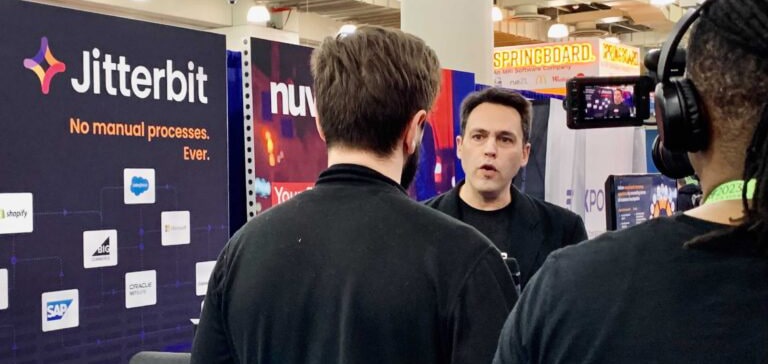By Greg Belkin, Senior Director, Product Marketing
Retailers who prioritize omnichannel experiences, employee engagement, and workflow automation will see measurable growth.
Last month, Jitterbit’s team of retail solutions experts hit New York City to join 35,000 attendees and 350 speakers from across the globe for the National Retail Federation’s (NRF) annual conference. NRF 2023 was filled with inspiring talks of inclusivity and innovation, cutting-edge technology solutions, and ideas to help move the needle forward in the retail sector.
Team Jitterbit was busy at booth #1234 — did you catch us there?

If you missed the fun, don’t worry. We’ve rounded up three key takeaways from the show that you can expect to see disrupting the retail industry this year.

-
Retailers who are omnichannel obsessed will see more customer loyalty and retention.
If NRF 2023 taught us anything, it’s that omnichannel strategies have never been more important. Companies are future-proofing by investing in omnichannel experiences that prioritize customer intimacy. The last few years have shown us that there will always be something – whether it’s a global pandemic, an economic recession, supply chain issues, inflation…the list goes on. Creating unique experiences that meet your customers where they are is key to weathering the storm (whatever that storm might be).
How do you do it?
Creating true omnichannel experiences means leveraging technology to meet, excite, and serve your customers via every shopping avenue. Oh, and if you’re still hesitant to invest in the brick-and-mortar experience – don’t be. The in-store experience has made quite the comeback, with Geoffroy van Raemdonck, CEO of Neiman Marcus, confirming a majority of their stores are at the high-water mark compared to where they were pre-pandemic.
New technologies, like smart fitting rooms and digital personal shoppers, are examples of ways that digital and in-store worlds are merging to create “phygital” experiences for shoppers. The first step in creating omnichannel experiences for consumers is data integration. Integrating key endpoints and data sources enables connectivity across digital and in-storetouchpoints to help facilitate a seamless, end-to-end experience.
-
The customer is still king, but your employees should be treated like royalty too.
Are you treating your employees with the same care and attention as you pay your customers? You should be. Retailers who prioritize the employee experience the same way they do the customer experience will accelerate growth immeasurably. Employees who feel valued by their employers, passionate about their work, and equipped with the tools they need to succeed will not only be more productive— they’ll treat customers with more care and attention.
How do you do it?
Develop an employee value proposition (or EVP) that aligns with your company’s mission and goals to excite employees and build brand loyalty from the inside out. Invest in technology that empowers employees to succeed and reach their personal and professional goals. Workflow automation and no-code application development tools eliminate manual tasks and enable employees to solve their own business challenges, freeing up time for them to focus on more important things (like your customers).
-
Automation is the answer.
Retailers are heavily prioritizing automation this year, and for good reason. Automating key retail processes — like managing inventory, processing orders, and sending shipping notifications — is essential to satisfy customers’ need for immediacy and intimacy. Automation also ensures accuracy between your warehouses and distribution centers, preventing errors, delays, and inaccurate product information. Automating the exchange of information via electronic data interchange (EDI) also helps brands meet compliance guidelines with trading partners.
How do you do it?
Invest in a unified data integration and workflow automation platform to facilitate a bi-directional data flow between front-end systems, commerce platforms, and EDI to back-end ERP, inventory/warehouse management systems, CRM, and more.
Learn how Jitterbit’s Commerce 360 solutions can help you create omnichannel experiences, improve employee retention, and automate key processes to accelerate growth.



